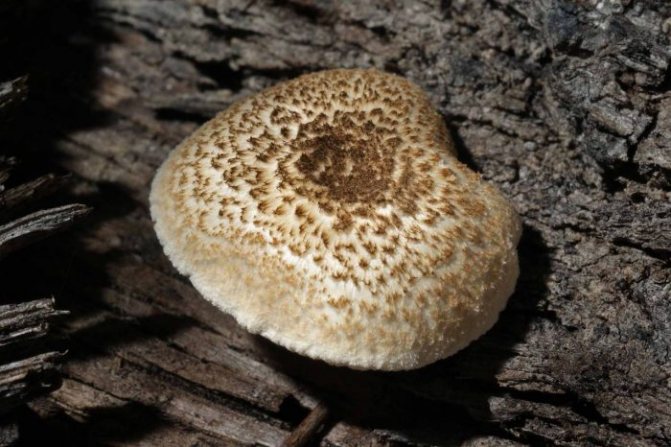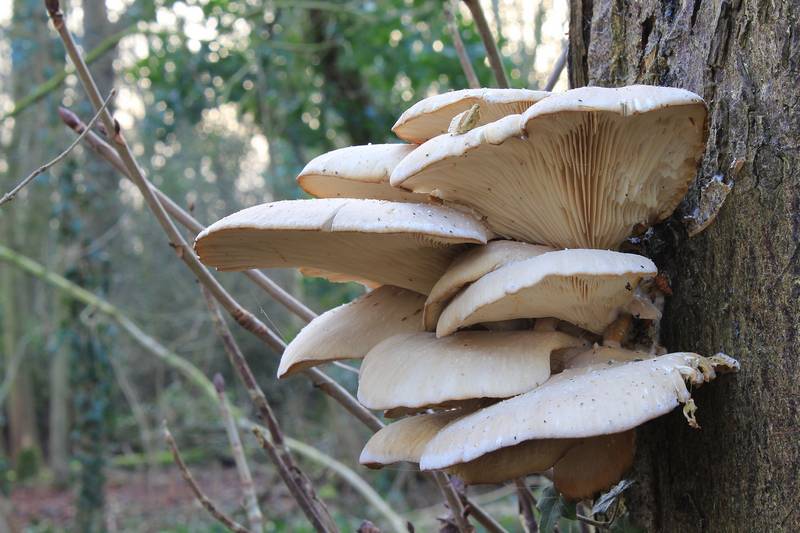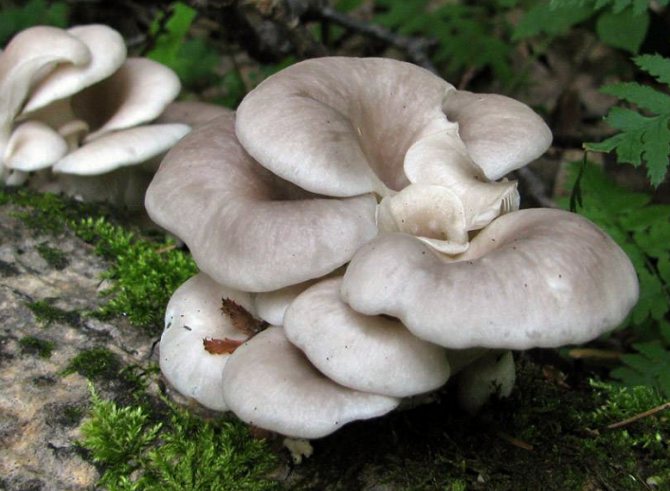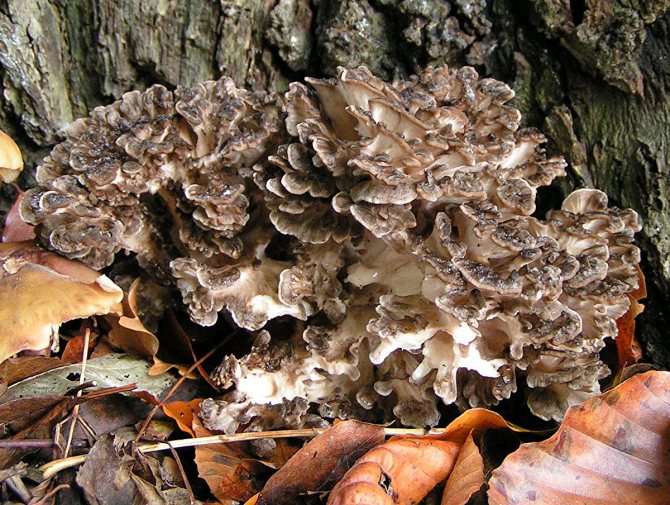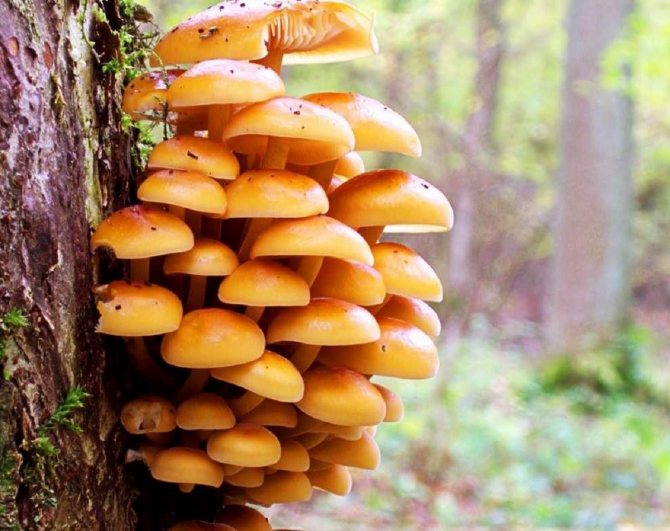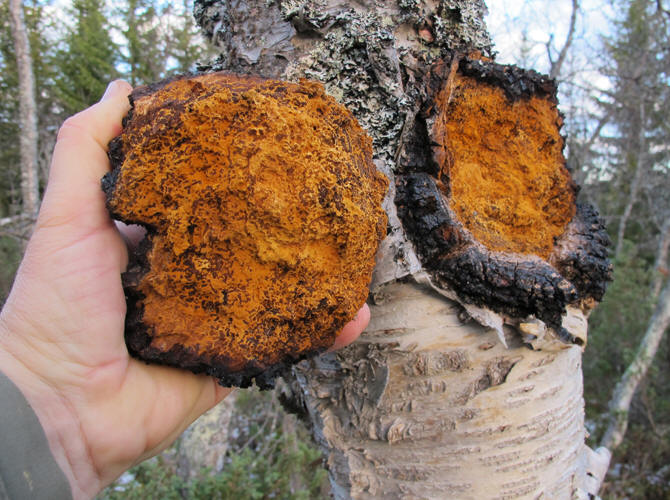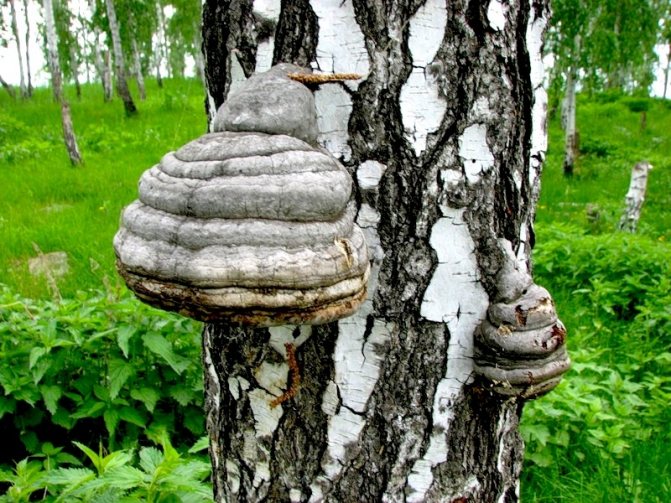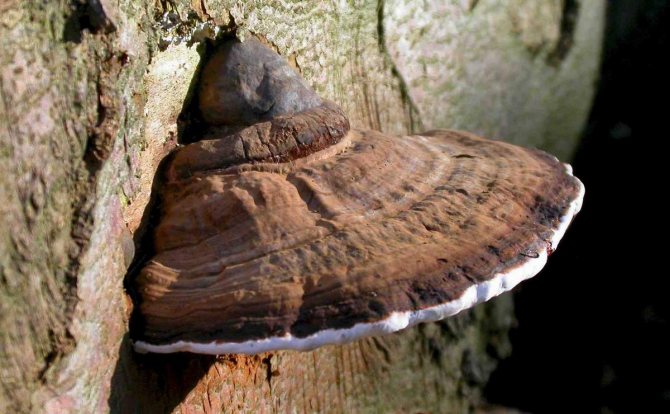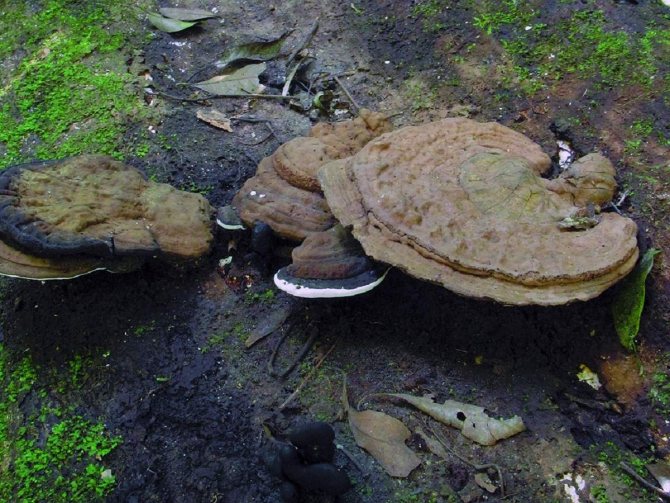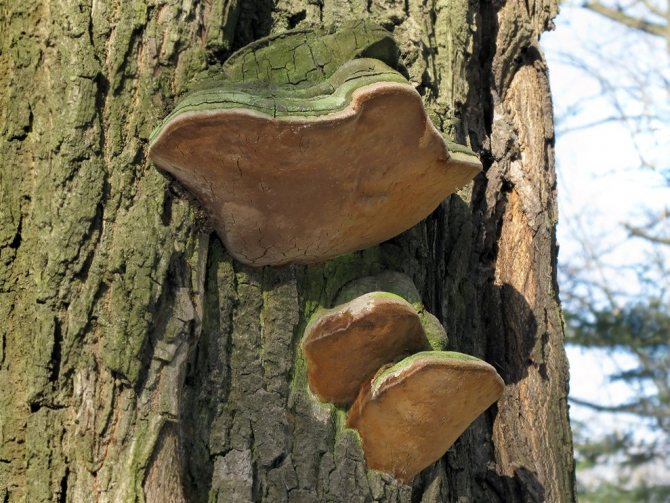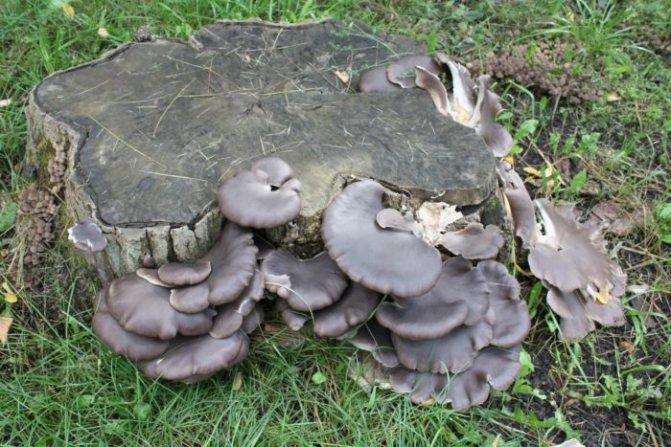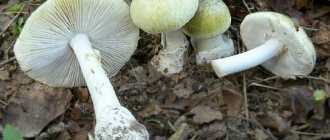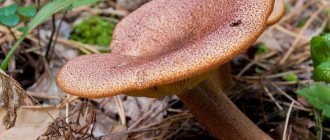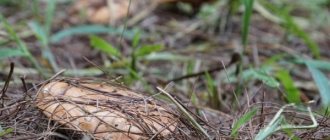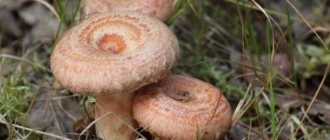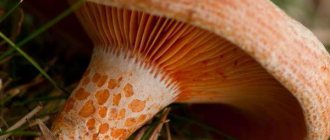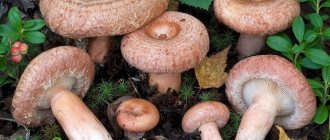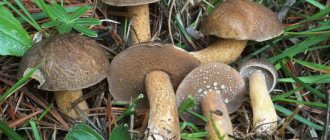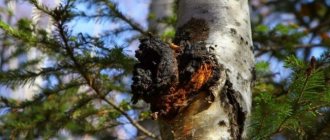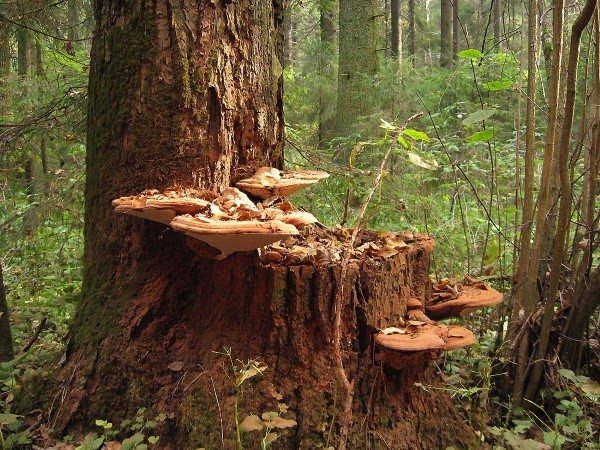
Surely many of us have seen such a picture more than once: interesting growths of a bizarre shape grow on stumps, trunks and branches of trees, or mushroom bodies with legs and caps that are quite familiar to everyone. These are xylotrophs - a separate group of woody fungi that grow on tree species and receive food from there.
By their nature, they are parasitic fungi and the appearance of such fungi on forest or horticultural crops means that the latter will die sooner or later. Spores penetrate into the wood through the slightest crack in the trunk, settle there and begin to actively multiply. Xylotrophs secrete special enzymes that break down wood polysaccharides, including cellulose, and thus mycelium feeds, taking nutrients from the tree. Due to the high concentration of carbon dioxide inside the wood, formed during the development of mycelium, the growth processes of woody fungi have a high speed.
Some species prefer to settle on dead trees, while others prefer exclusively living wood, and there are some mushrooms for which this does not really matter. Take, for example, honey agarics - they are able to develop on any species, regardless of whether the tree is dead or not.
Most woody mushrooms have a wide, large cap and a short stem, or none at all, and the flesh has a tough structure. It is almost impossible to separate some specimens from the owner, so many people think that xylotrophs have no place in the kitchen. Indeed, inedible species of woody mushrooms prevail in their numbers, however, there are also mushrooms with good gastronomic characteristics among them.
Delicious Edible Xylotrophs


One of the most famous edible woody mushrooms is everyone's favorite oyster mushrooms. Under natural conditions, their mass accumulation can be seen in the Crimean deciduous forests, but oyster mushrooms are also successfully grown in artificial conditions on a special substrate. They grow in large families, the weight of one can exceed 3 kg. One of the most delicious and uncomplicated mushrooms to grow is oyster mushroom or oyster mushroom. It grows in large, multi-tiered and dense "nests", large caps up to 25 cm in diameter have the shape of a funnel and folded edges. As for the color, they are most often light ash, although there are other color variations, from yellowish to dark gray. Under the cap there are rare, wide and white plates, which turn yellow in old mushrooms. The short stem is almost invisible. The pulp has a pleasant smell, white, dense structure.
Oyster mushrooms can live on almost all deciduous trees, dead or weakened. The only exception is oak.
In addition to oyster mushrooms, edible tree mushrooms include:
- Winter mushroom (aka winter mushroom, velvety-legged colibia, enokitake). A small cap with a diameter of up to 10 cm is convex, colored yellow-brown. The stem is thin, tubular, brown, with a reddish tint in the upper part. The pulp is fragile, yellow, smells good, tasty. You can even eat old mushrooms, but without legs.


- Shiitake (aka the imperial mushroom, edible lentinula or Japanese forest mushroom).The mushroom is similar in shape to a meadow champignon: an umbrella-shaped brown cap with light plates and dry scaly skin grows on a fibrous stem. The pulp is light, fleshy, with a light peppercorn. They are widely used in Chinese medicine due to not only their high culinary, but also their medicinal properties.


- Muer (aka black Chinese mushroom, auricular auricular or Judas ear). Prefers dead alder trees, in nature it grows mainly in China, but in our country it is found in the East. The fruiting body is thin, auricle-shaped, brown in color. The pulp is tender, jelly-like and silky, slightly crunchy, but becomes rough with age. Healing.


- Tinder fungus sulfur-yellow (aka chicken mushroom or witch's sulfur). It grows on weakened living deciduous trees in the form of multi-layered growths of yellow-orange color. Young pulp is very tender, juicy and tasty, old pulp is tough, dry and sour.
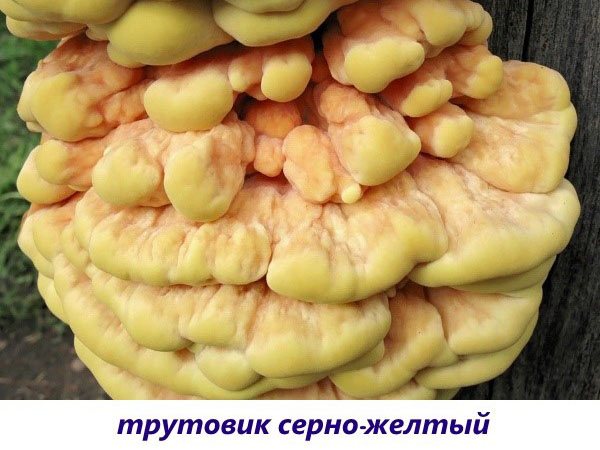

- Curly griffin (aka ram mushroom, leafy tinder fungus or maitake). It grows mainly on stumps of broad-leaved species. The fruiting body consists of many legs, smoothly turning into leaf-shaped caps with wavy edges, painted gray-green-brown with a darker center. The pulp smells like nuts, light and fragile. Old mushrooms are dark and tough.
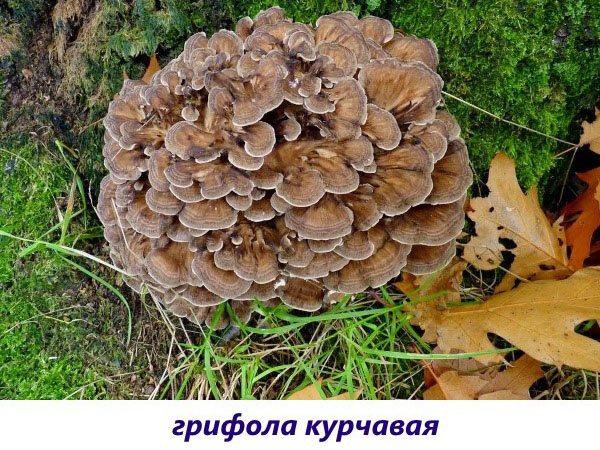

Among the species of woody fungi growing in the form of an outgrowth, young fruit bodies are the most delicious.
How not to be mistaken in your choice?
Among the mushrooms on the wood, there are not only honey mushrooms, it is also tinder fungus, oyster mushrooms, scales, liverwort. They are edible, poisonous, and medicinal. Let's get to know them better.


Edible
Not all of the mushrooms listed below are tasty and nutritious, however, they do not bring any harm to health. Some of them are well known and popular with experienced mushroom pickers. Here is a list of edible mushrooms growing on trees, with photos and descriptions:
- Oyster mushroom (Pleurotus cornucopiae). Has a cap in the shape of a horn or funnel. It is light, slightly gray in color. It has a diameter of 3-12 cm. The leg of the oyster mushroom is located in the center, covered with descending plates, 2-6 cm long. The flesh of the oyster mushroom is white, fleshy, elastic. The mushroom has a slightly pronounced, almost imperceptible aroma and taste. Inhabits deciduous crops from May to September.
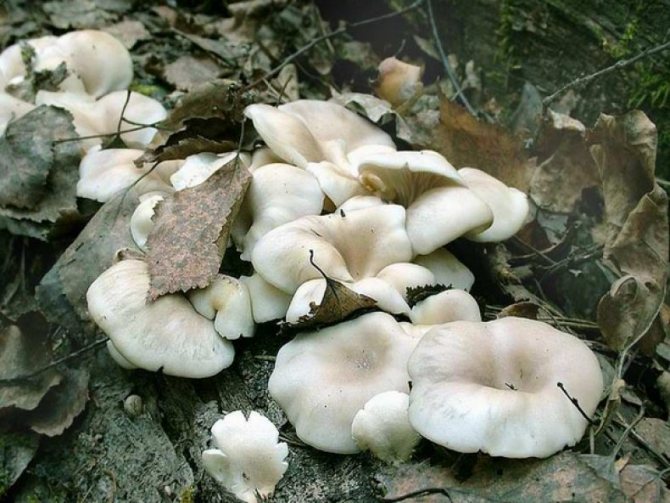

- Curly griffin (Grifola frondosa).It also has other names: mushroom-sheep, dancing mushroom. The specimen is easily recognizable by the pseudo-hat joint and the light leg. Its pulp is white, fibrous. It has a pleasant taste and aroma. Fruiting from June to October. Most common at the base of oak and maple trees. It can weigh up to 10 kg.
Poisonous
Among the fungi that parasitize trees, there are, of course, more inedible ones and even those that can cause serious harm to the human body. Here is a list of the most common inedible mushrooms growing on trees, with photos and descriptions:
- Ganoderma southern (Ganoderma australe).The hat of this specimen is flat and very large - up to 40 cm in diameter and up to 13 cm in thickness. Has brownish, gray, brown shades. There are almost no legs. The pulp of the fruiting body is soft, brown or reddish in color. Likes to settle on poplars, oaks and lindens.
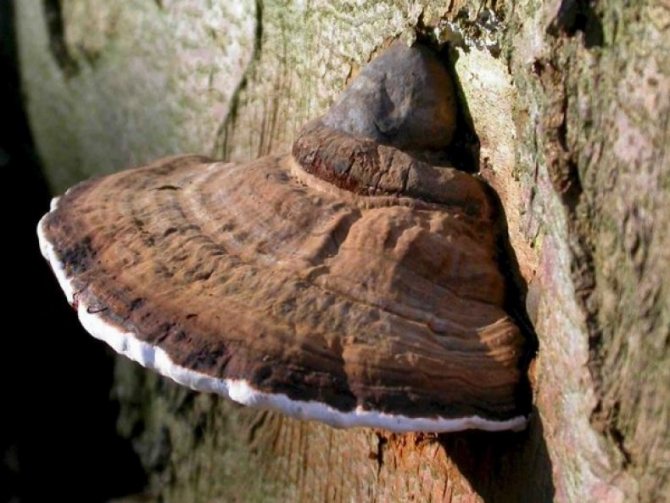

Therapeutic
Some mushrooms, growing together with the tree, form fruiting bodies that have medicinal properties. From them, traditional healers make medicines. These, for example, include mushrooms growing on trees, with photos and names of which you can find below.
- Larch sponge (Fomitopsis officinalis). Its other name is agaricus. The fruiting bodies of the fungus resemble hooves, and can also be oblong-cylindrical. Reach weights up to 10 kg. White, grayish-white, pale yellow in color.They grow on conifers, most often on larch. Means based on the fungus weaken, stop the blood, act as a sedative, have a mild hypnotic effect. Also used to reduce perspiration.
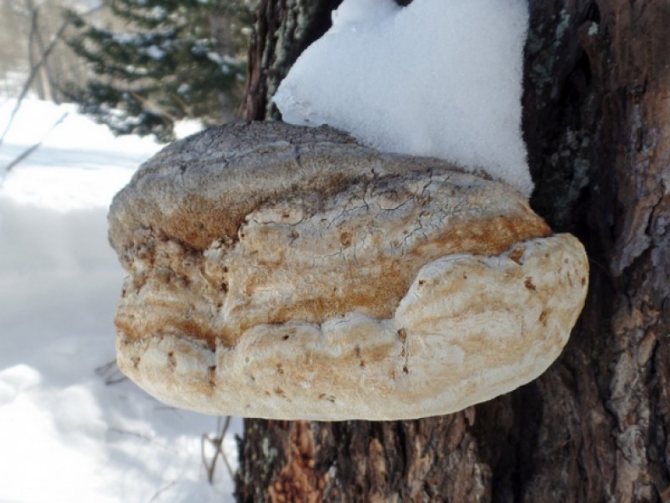

- Lacquered polypore (Ganoderma luc>
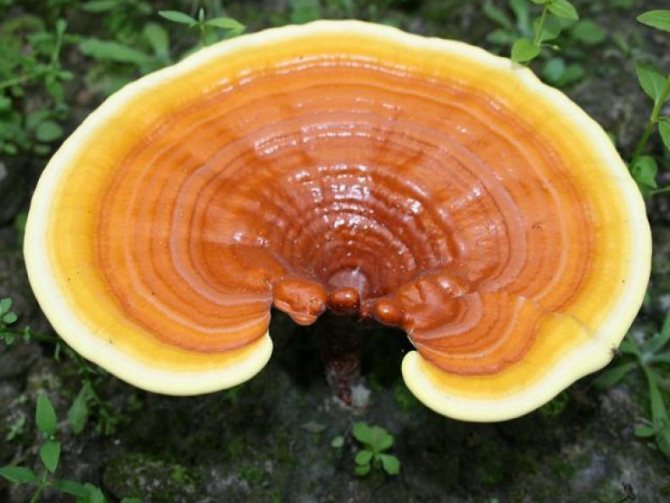

- Tinder fungus (Inonotus obliquus), also known as chaga or birch mushroom. The fruit body grows in diameter from 5 to 40 cm. It has the shape of an irregular growth. It comes in black. Covered with many small cracks. It usually lives on birches, but it can also affect alder, maple, mountain ash, elm. Means based on slanted tinder fungus are used for antitumor and protivogastritis purposes. They have antimicrobial, antispasmodic, diuretic effects.
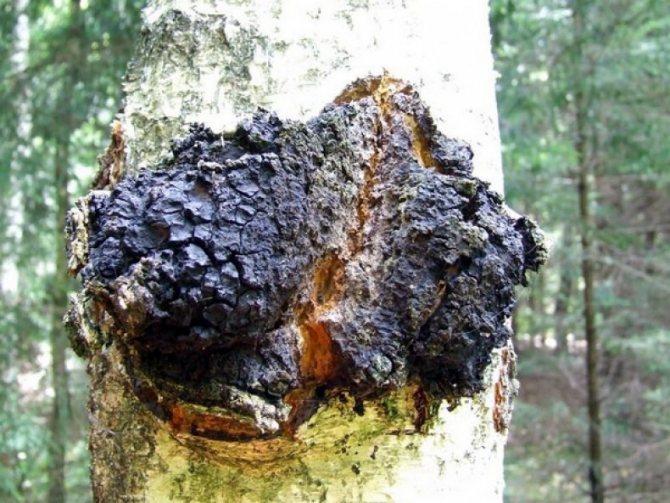

Inedible but very beneficial xylotrophs
As already mentioned, most woody mushrooms have a tough pulp, which is not at all pleasant to eat, and in some cases it is simply impossible, because it is so hard. However, among them there are very valuable specimens from a medical point of view. On their basis, medicinal products are made that help fight many diseases, including such as oncology.
Some of the most useful woody inedible mushrooms are:
- Chaga larch birch. The fruit body is hoof-shaped, rough, cracked. The skin is off-white, darkens with age. It is a long-liver, a parasite on a tree for up to 20 years, the weight of one mushroom reaches 3 kg. Chaga pulp is yellowish. Most of the nutrients are found in young mushrooms growing on living trees.
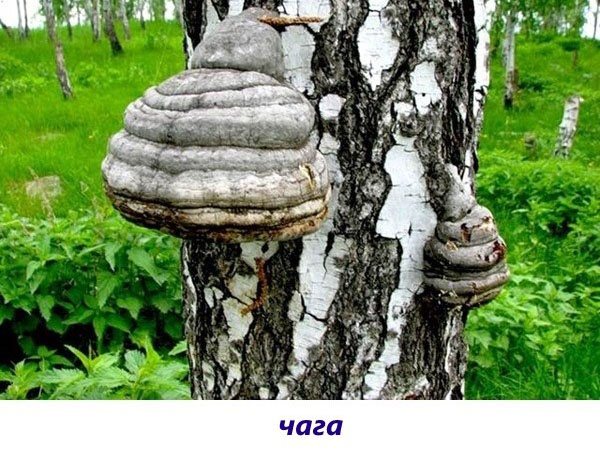

- Lacquered polypore (aka Reishi). Grows on stumps and diseased deciduous trees. It has a small but very dense leg attached to the side of a very beautiful egg-shaped hat. The surface of the lacquered tinder fungus is shiny and wavy. Rings of a darker shade than the main color go along the hat. The color can be different: orange, red and even yellow-black. The pulp is tasteless and odorless at first spongy, but quickly becomes woody.


Summing up, we can say that, although tree fungi are parasites that destroy trees and cause great harm to gardeners, nevertheless, some of these specimens are also useful, both in gastronomic terms and in medicine.
Video about growing edible tree mushrooms
Mushrooms growing on trees and stumps are edible or unsuitable for food. They use wood as a nutritious substrate. Some types of such fungi parasitize, disrupting the integrity of living tissues; others process dead wood and become food for birds and animals. Medicinal compositions are prepared from some types of woody mushrooms.
Tinder fungus sulfur-yellow
Many varieties of this mushroom have a good reputation. The people gave the motley tinder fungus a tender name - pestle. This is an early mushroom, you can collect it from May. It prefers woody debris from deciduous trees, but it can also appear on living plants.
This mushroom should only be picked when young. It is generally not worth collecting old ones, they accumulate various harmful substances from soil, water and air. Young variegated polypores have tasty and tender pulp. They are fragrant and fleshy, which makes mushroom dishes especially tasty. But the old mushroom grows stiff and is suitable only for broth, but after cooking it will have to be thrown away. The polypore grows old very quickly, but gives several harvests per season.
Popularly, these mushrooms growing on stumps are called witch dough. They protrude from the stumps like slugs. Despite the eerie name, the mushroom is edible and quite tasty, has a light yellow color, very delicate and soft. It tastes like a fluffy omelet. But, as soon as the mushroom hardens, it is no longer possible to eat this tinder fungus.
Edible woody mushrooms
Many edible mushrooms can be seen on stumps and trees. It:
- Wild oyster mushrooms... In turn, they are subdivided into species such as pulmonary, orange, horn-shaped mushrooms. They grow in hardwood forests. You can meet wild oyster mushrooms on rowan and oak stumps from May to September.
- Winter mushroom... These mushrooms have a convex brown cap, and the legs are covered with villi. They can be seen on damaged deciduous trees. Often, winter mildew inhabits dried poplars and willows. Fruiting from autumn to spring, it can winter even under a layer of snow.
- Liverwort... The tree mushroom got this name due to its color, which is close to a bloody shade, and dense fleshy pulp: its cut resembles a raw liver. In shape, it resembles a tinder fungus. The color of the liverwort's cap is red-brown. Such a mushroom grows on living trees, mainly on chestnuts, oaks, less often on other deciduous trees. The liverwort should be eaten only when the mushroom is not yet old.
- Real (or autumn) mushrooms... The color of these mushrooms is different: light brown, brownish, reddish. They grow on acacia and poplar stumps. There must be a light membranous ring on its thin leg. This is the hallmark of edible mushroom.
- Curly griffin (or ram mushroom)... The fruit body of such a mushroom is branched, has many caps. The diameter of the mushroom "bush" can reach 80 cm, and the weight - 10 kg. Sheep mushroom is the largest type of mushroom growing on trees. Color - gray, brown, yellowish brown. Curly griffin is harvested in August and September in broadleaf forests. They are found on the bases of maples and old oaks, beeches and chestnuts.
- Tiger saw-leaf... The color of this woody mushroom is white or slightly yellowish. On its surface there are black and dark brown scales. The flesh of the mushroom is tough. Sawwood is high in protein. Collect it from mid-summer to October.
- Coral blackberry... This mushroom has a specific appearance: it has a large, well-developed aerial part. Its fruiting body looks like a sea coral bush: it has many short tentacles. The color of blackberries ranges from snow-white to cream with a slightly yellowish tinge. Such a mushroom grows on fallen trees, in old hollows. The preferred trees are elm, oak, linden, beech. This mushroom can be added to various dishes, as well as prepared medicines based on it.
- Edible tinder fungus... They grow both on living trees and on the stumps of coniferous or deciduous crops. Sometimes tinder fungi grow in gardens, on fruit trees. The most common type of edible tinder fungus is the variegated, or woody, mushroom. A sulfur-yellow mushroom is also found. They grow from May to September. Outwardly, they resemble large, flat, overripe chanterelles. The diameter of the cap varies from 10 to 40 cm.
List of edible forest mushrooms with photos and tips for novice mushroom pickers
Mushrooms are considered edible, which can be used for food absolutely without risk to life and health, since they have significant gastronomic value, distinguished by a delicate and unique taste, dishes from them do not become boring and are always in demand and popularity.
Good mushrooms are called lamellar, on the underside of the caps there are lamellar structures or spongy, since their caps on the underside resemble a sponge, inside which there are spores.
During the collection, experienced mushroom pickers always pay attention to special signs that the mushroom is edible:


the frequency of the location of the plates;- what color is the dispute;
- how the plates are attached to the leg;
- change in the color of the pulp when pressing on it.
Forest mushrooms grow from mycelium, which resembles a grayish light mold that appears on a rotting tree.The delicate fibers of the mycelium entwine the roots of the tree, creating a mutually beneficial symbiosis: the fungi get organic matter from the tree, the tree from the mycelium receives mineral nutrients and moisture. Other types of mushrooms are tied to tree species, which later determined their names.
The list contains forest mushrooms with photos and their names:
- boletus;
- bottom bearing;
- boletus;
- poddubovik;
- pine mushroom;
- speckled or common oak, others.
In coniferous and mixed forests, there are many other mushrooms that mushroom pickers are happy to find:
- chanterelles;
- mushrooms;
- mushrooms are summer, autumn, meadow;
- boletus;
- Champignon;
- russula;
- milk mushrooms;
- polish mushroom, and so on.
It is most correct to put mushrooms during picking in special wicker baskets, where they can be ventilated, in such a container it is easier for them to maintain their shape. You cannot pick mushrooms in bags, otherwise, after returning home, you can find a sticky, shapeless mass.
It is allowed to collect only those mushrooms that are known for certain that they are edible and young, old and wormy should be thrown away. It is better not to touch suspicious mushrooms at all, bypass them.
The best time to harvest is early in the morning, as long as the mushrooms are strong and fresh, they will last longer.
General features and harm of parasitic fungi for trees
The fact is that, upon closer acquaintance, it becomes clear: some mushrooms settle on healthy trees, gradually killing them, while others - on sick, dying ones, utilizing them, performing work to clear the forest and increase the fertile soil layer. The first are parasites, the second are saprophytes.
A distinctive feature of parasitic fungi is their predatory behavior towards a tree: they feed on its juices, destroying it. For the tree, this is a direct threat and no benefit, in contrast to symbionts (feeding the tree with trace elements and moisture, and receiving sweet carbohydrates in return; here there is an honest exchange), to which we are more accustomed in terms of collection: boletus, boletus, milk mushrooms, chanterelles.
If the parasite has settled on a tree, then it is unlikely that it will be possible to remove it, usually this tree is doomed. After all, what we see on the surface is just a part, a fruiting body. And inside the trunk, everything is braided with a network of roots, a mycelium, which can no longer be removed without destroying the tree.
And if this tree was alive, then, of course, the mushroom is a pest for it. But most often parasites settle on damaged trees, with wounds, hollows, and weakened ones. Spores find a vulnerable spot and take root there, developing mycelium.
Edible mushrooms growing on trees
Among parasites and saprophytes, there are a certain number of those suitable for food. Moreover, they have quite high taste and even medicinal properties. Consider a few edible species:
- Oyster mushroom horn-shaped. Refers to lamellar. Quite popular, even grown at home or in industrial farms along with mushrooms. It got its name due to its shape, it bears fruit from spring to autumn. It grows on fallen trunks and stumps, attaches to them with a leg 1 cm in diameter and up to 5 cm long. The hat is asymmetric, with a funnel in the region of the leg, the size varies between 4-15 cm, the color is gray, sometimes a yellowish tint.
Oyster mushrooms growing on trees in "bouquets" can be seen in the photo, it is difficult to remember the mushroom from the description alone. They are in the fourth nutritional category. Use them for stewing, frying, pickling. Boiled ones are used in salads instead of meat in vegetarian dishes or during fasting, as they are most suitable for this substitution due to their dense pulp. - Winter honey mushroom. Bright yellow and red color is its distinctive feature. The cap is rounded, becomes flat with age, reaching 9 cm in diameter. The leg is thin and stiff, usually not eaten. Honey mushrooms belong to the third food category and are valuable fried and pickled.The composition contains substances used as antineoplastic and antiviral.
- Curly griffin. This edible specimen belongs to tinder fungi and is listed in the Red Book. Loves broad-leaved trees, is attached at the base of dead wood or on a stump with the help of lateral legs. The taste is bitter, therefore, exclusively young mushroom bodies are taken for food. It grows very quickly, there are recorded representatives weighing 7 kg. The color depends on the amount of sunlight received: it can be pink, gray, green. Not affected by pests.
- Tinder fungus is sulfur-yellow. Also known as chicken mushroom. It is notable for its bright color, comparable to volcanic lava. Prefers a warm climate, settles on old trees, is attached with a fan-shaped hat to the trunk, without a leg. Moreover, several hats usually have one base. They grow up to 40 cm and 10 kg. Used in oriental medicine. In cooking, they prefer to fry it.
- Tiger saw-leaf. The young cap is convex, with time it turns into a funnel-shaped one with curved edges. The color is white, beige with brown scales. It belongs to saprophytes, since it settles only on dead wood, gradually building up white rot there, digesting wood fibers. Valuable for a large indicator of protein in the composition, but only at a young age.
It is worth recalling that all edible woody mushrooms are eaten only when young. Old fruiting bodies are often not only tasteless, bitter, but can also cause indigestion and even sometimes hallucinations.
Inedible and poisonous species
Most of the rest of the mushrooms that grow on trees are not edible and even dangerous. Experienced mushroom pickers advise for your own safety to bypass them, and also remember the appearance and names.
You may be interested in:
Care and use of kombucha at home (+22 photos)
The edibility of a variegated umbrella mushroom and its description (+19 photos)
Description of edible and inedible oil, their poisonous counterparts (+40 photos)
Some types of inedible:
- Ganoderma southern - settles mainly on oaks, poplars growing in the southern regions. The hat is thick, reaches 10 cm, and the diameter is up to 40 cm. The color is brown with variations, the surface is slightly bumpy.
- Fluffy trametes - grows in groups on stumps and felled birches. It is noticeable in white shades of color with a transition to gray, yellow, beige and hairiness on the cap. The size reaches small, up to 10 cm in diameter.
- Oak tinder fungus, piptoporus is a rare species in our latitudes. It grows mainly on living oak trunks, but it is also found as a disposal of dead wood. It can be of various shapes: spherical, flat, shapeless with growths. The color is whitish below, the top is orange-yellow, the surface itself is velvety at a young age, and over time it becomes hard with cracks.
- Astringent post - attracts with its white color. In young specimens, the release of liquid drops is observed - gutting. The pulp is fleshy, with an astringent bitter taste. But it belongs to unexplored mushrooms, the poet is not recommended to eat it.
- Ischnoderm is resinous - like the previous representative, during the growth period it secretes liquid (this time brown or reddish) and has a bitter taste. Utilizes dead coniferous wood. Most often they grow singly. The velvety hat is painted in shades of brown, sizes up to 20 cm.
With regards to poisonous species, it should be remembered that they usually disguise themselves as edible: there are false mushrooms, oyster mushrooms. Without solid knowledge of what a specific mushroom body looks like, you should not take it home.
Medicinal mushrooms
Most often, woody mushrooms are used for medicinal purposes, since they have a rich composition of trace elements and rare chemical compounds.The most famous:
- Reishi, a lacquered tinder fungus, was highly prized in ancient Eastern medicine, quite rare and expensive, even appearing as a part of the bride's dowry and "overgrown" with legends. Currently, in Japan and China, it is grown on farms specifically for pharmacology. It is used as an antitumor agent, immunomodulating, positively affecting pressure, digestion, fat metabolism, blood circulation.
Reishi preparations for weight loss are very popular now. Should not be taken together with drugs of a similar principle of action, for example, with immunomodulators. The name "lacquered" is derived from the glossy sheen of the surface. - Chaga, mown tinder fungus - is widely used in the treatment of the gastrointestinal tract, in dentistry, endocrinology, dermatology, has antispasmodic properties, antimicrobial, diuretic. There is evidence that it stops the growth of malignant tumors. Grows on birches. Outwardly, it often looks like a shapeless growth of gray and black, bumpy. Brown inside. In case of an overdose, it causes nervous excitement, increased pressure, and increased heart rate.
- Larch Sponge - Contrary to the name suggesting deciduous trees, it loves conifers, including larch. Looks like a multi-layered hoof with bumps. Perennial mushroom, the largest officially recorded age - up to 70 years. The dimensions are also rather big: the diameter is up to a meter, the weight is several kilograms.
The therapeutic effect of this tinder fungus is a laxative, hypnotic, sedative, it has a positive effect on the metabolism, on the liver. It is used in the treatment of tumors, tuberculosis, hepatitis, diabetes, asthma. Not recommended for pregnant and lactating women.
Contraindications in the treatment of mushroom remedies in most cases are in the individual intolerance of a particular element in their composition. In any case, it is categorically impossible to self-medicate, always seek advice from your doctor.
Answers to common questions
Mushrooms are quite complex organisms, and often hazardous to health, so a lot of questions arise about their collection and use.
Are all fungi that grow on trees a parasite?
No, there are varieties that have settled on an already sick dying plant. They did not become the reason for his death, and, on the contrary, in nature they play the role of orderlies, clearing the forest from debris, turning trunks and stumps into humus.
How to remove a mushroom from a tree?
To use the mushroom itself, it is simply cut close to the bark, without damaging the attachment point. If we are talking about how to remove the parasite from the trunk, then in most cases this process is useless, since the fungus consists of a mushroom body and mycelium, that is, the roots that are in the trunk and it is impossible to remove them from there. Cutting off the fruiting body, unfortunately, will not cure the tree, it may just prolong its life a little.
Mushrooms from which trees are the most dangerous in our area?
There is no especially dangerous, deadly poisonous tree fungi in our latitudes and there is no relationship between the “toxicity” of the fungus and the species of wood. But this does not mean that all of them can be eaten. Many of them can cause health problems, especially if you consume too much of them.
Like all common edible mushrooms, woody mushrooms are also healthy and even tasty in many ways. The main thing is to study them so as not to make mistakes when collecting, as well as their preparation and processing features.
Subscribe to our channel in Yandex.Zen! Click "Subscribe to the channel" to read Ogorod-in the "Yandex" feed
Inedible poisonous mushrooms growing on trees and stumps
Inedible parasitic fungi can also grow in these areas. They are unsuitable for human consumption and cause severe poisoning. Some of them are not poisonous, but should not be eaten.
These mushrooms include the following types:
- Ganoderma southern... It grows from a tree. This mushroom has practically no stem, and the cap is flat.A wide part of the ganoderma grows to wood or earth. The pulp is dark, soft and tender.
- Fluffy trametes... This inedible woody mushroom has a gray surface and leathery flesh. It often grows on coniferous wood as well as birch trees. Trametes usually appear on stumps.
- Piptoporus oak... The mushroom has a large fruiting body. The diameter of the hat is 10-15 cm, its surface is velvety. The color varies from white-yellow to brown. Most often, piptoporus grows on the bark of an oak tree.
These types of mushrooms should not be eaten even after thorough heat treatment. If the mushroom is unknown, it is better to leave it on the tree.
Row gray - description and photo
In September - October (and even in November, if the weather permits), sometimes a lot of mushrooms with gray caps are found in our forests.


They can grow singly. But other specimens are always found nearby. They can grow in "heaps", literally piling up one on top of the other. They can form "witch rings".
For the gray color of their caps, these mushrooms are sometimes called "mice". The Russian scientific name is ryadovka gray. And since the surface of the caps, especially in large fruiting bodies, is covered with a net of cracks, a kind of "shading", the mushroom is also called a streaky row.
This mushroom is not only completely edible, but also has a pleasant taste and aroma. Yes, and it is quite simple to prepare the gray ryadovka.
The gray ryadovka is not at all a close relative of the purple ryadovka, which I already wrote about. These mushrooms belong to different genera of the Ryadovkov family. Here are the Latin names of mushrooms, this fact is recorded very accurately.
The purple row belongs to the Lepista genus, and in Latin it is called Lepista nuda. Ryadovka gray is a representative of the genus Tricholoma, its Latin name is Tricholoma portentosum.
The gray ryadovka forms mycorrhiza with Scots pine, and grows in the forests where this tree is found. True, I have not yet met this fungus in clean pine forests. But in coniferous-deciduous forests, where pine, spruce, birch and aspen grow, gray rows can sometimes be collected quite a lot.
The row is gray (dashed) - the mushroom is rather large and dense. A hat in diameter ranges from 5 to 15 cm, and the length of a rather thick leg reaches 10 cm or more. True, most of this long stem is usually hidden in moss or forest floor.


The hat is bell-shaped at first, later becomes open. There is no pronounced tubercle in the center of the cap. The top of the cap is covered with a gray skin. This skin, especially in large mushrooms, cracks and creates a kind of pattern ("shading").
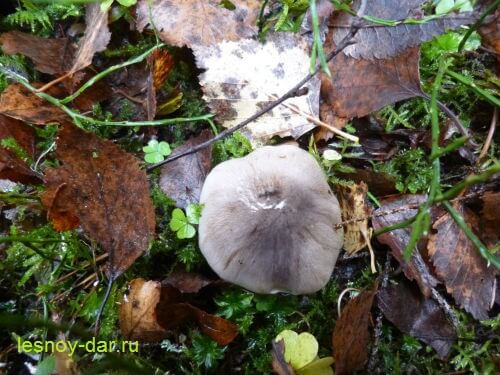

On the underside of the cap there is a spore-bearing layer (hymenophore) of thick and rather rare white plates. In old mushrooms, the plates may turn yellow. The records not only do not run down on the leg - they do not even reach it a little.


The leg is long, often curved, rather thick and dense. The base of the leg is slightly thickened. There is usually no cavity inside. It can appear only in the old fruiting body.


The gray row has a rather pleasant smell. They write about the smell of "fresh flour". I don’t know, but it seemed to me just not too pronounced “mushroom aroma”. In any case, this mushroom does not have any sufficiently pungent and unpleasant odor.
What mushrooms are similar to a row of sulfur?
Attentive readers of my blog probably know that I am not a supporter of the "fairy tale about false mushrooms" widespread on the Internet. They say that every edible mushroom has a counterpart very similar to it - a "false mushroom". And terribly poisonous! He is only busy with watching over and poisoning the mushroom picker! Such are the horrors ...
Only all these horror films, I repeat - fairy tales (or, to put it more solidly - one of the "mushroom myths"). All these "false white", "false boletus" and so on, with which many Internet authors scare us.
You just need to look more closely at the mushroom, remember its features.Nowadays almost everyone has cameras on their phones. Take off, search on the Internet. You will definitely find it.
One day was enough for me to get acquainted with the gray ryadovka. Found in the forest - photographed - looked in the identifier - checked my guess on the Internet. There is a good group on Facebook - that's what it's called
"What kind of mushroom?"
... Advanced users and competent experts will definitely give you a hint. If only your photos were informative.
There are still mushrooms in the forest that look like a row of sulfur. What unites them is not only the gray color of the hats. They all belong to the genus Tricholoma. But each of these mushrooms has its own characteristic distinguishing features.
The edible earthy ryadovka is smaller and thinner than the gray ryadovka. And her plates are not white, but gray.
Inedible soap ryadovka has a pungent unpleasant odor, for which it got its name. And her plates are greenish.
The inedible (or even slightly poisonous) pointed row is distinguished by a pronounced characteristic tubercle crowning the middle of the cap. Ryadovka gray does not have such a tubercle. And the taste of the pointed ryadovka is pungent and pungent.
Features of growing mushrooms on stumps
The types of mushrooms that grow on stumps can be bred at home, creating for them as close to natural conditions as possible. The best option is to grow wood mushrooms in a summer cottage.
For stumps, you need to use cuts from deciduous trees, or use real stumps left over from recently cut trees.
Most often, oyster mushrooms are grown on the site. To ensure their growth and normal development, you need to take poplar, birch, maple wood. Conifers should not be used, as they contain a large amount of caustic resins that can destroy the mycelium.
If fresh wood is used, then it is not necessary to soak or moisten it first. If the stumps are old, then they need to be kept in a container of cold water for several days.
After the logs are ready, you can add the mycelium of the selected type of woody mushroom. To do this, you can make holes in the hemp in a checkerboard pattern. Their depth should not be more than 6 cm, and their diameter should be 1 cm.
The mycelium should be poured into these holes. After that, they need to be covered with moss or closed with adhesive tape.
The logs with mycelium must be placed in the basement. They should be folded in a pyramid shape and covered with burlap.
The stumps should remain indoors until the mycelium sprouts. Then they can be placed in the ground. It is recommended to do this in May, when the normal temperature regime is established.
For planting hemp, you should choose a shaded place. You need to dig a hole no more than 15 cm deep, cover the bottom with wet leaves or sawdust. You need to place a stump in the hole. The distance between each of them should be at least 35 cm. Stumps should be watered if necessary.
Mycelium cultivation technology
To carry out the procedure for infecting a timber stock with a seed mixture, a minimum amount of materials is required:
- Wooden log.
- Mycelium.
- Ancillary equipment.
DETAILS: Perennials growing in shade and partial shade
For the purpose of cultivation, you can pick up any options for low-grade wood. But it is better to prepare those varieties on which the spores prefer to grow in natural conditions. The logs should not be older than 1-2 years. It is advisable to choose options with minimal signs of destruction, since mushrooms wear out the tree very aggressively and your growing environment will quickly exhaust its resource.
It is best to cook a damp and fairly fresh breed. The diameter of the blanks can vary from 15 to 30 cm. The best option is 20-25 cm.As mentioned, the most cost-effective family for home and industrial production is oyster mushroom. Mycelium of this kind is realized in several forms: various containers, plastic bags.
The main nuances worth knowing about are the substrate on which the mycelium is grown. The main types are: cereal grains, sawdust, bars, corn cobs. There is an opinion that the most promising option is a sowing medium grown on grains. However, no significant differences were found in base modifications.
The main requirements for storing mycelium are temperature (2 ° C) and humidity. A quality planting substrate is a white conglomerate that is hard to the touch. If it is significantly changed, then there will be no harvest. The extensive method involves the use of micelated gruel or water, which is easy to pour into the seating nests. The tools with which you will prepare logs for infection can be varied. Your best bet is to have:
- drill;
- chainsaw;
- industrial film;
- locksmith staple;
- container for sterilizing logs.
For sowing oyster mushrooms or other genera, wooden logs are harvested, which are sawn into blocks of 30-40 cm, pre-soaking them in ordinary water for 1-2 weeks. If the blanks are freshly cut logs, then they do not need to be soaked. The entire infection algorithm boils down to the following basic manipulations:
- Digestion of wooden blocks.
- Cutting out niches of primary growth.
- Seed medium preparation.
- Infection.
- Log wrapping.
To prevent the competitive growth of various microorganisms with fungi in the environment of wood and the destruction of antifungal substances, the method of heat treatment of the bar is used. To do this, place the logs in boiling water for 15-30 minutes.
For a better invasion of spores into a wooden blank and protecting it from adverse external influences, it should be correctly placed in a log. For this, several methods are used. The first and the simplest one consists in placing the mycelium on the end of the bar and laying on top of the next one. Thus, an artificial trunk is formed, in which each next layer protects the mycelium of the previous one. Straw or sawdust is laid on the surface of the uppermost one.
The second method is the imposition of holes on the log, which serves as a protection. To do this, use a conventional drill to drill several holes up to 1-15 cm in diameter to a depth of 10 cm. The method of sawing the upper layer of the bar is also used. For its implementation, a 4-centimeter layer of log is cut down. The mycelium is placed on it and covered like a lid. Then fix it with nails.
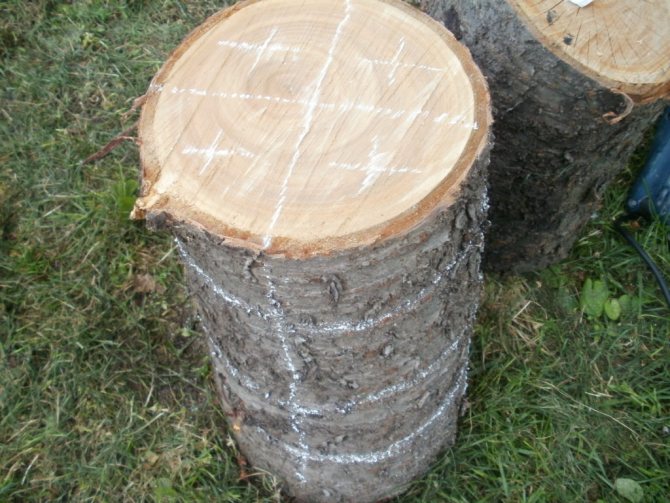

To achieve the desired consistency, the mycelium is ground by hand and placed tightly in niches for cultivation. Then they are tightly sealed with wooden valves or paper wads for better incubation.
The micellar environment constantly requires a certain water content for growth. The logs must be kept at 80% moisture for growth to be successful. To preserve this environment, the hemp is wrapped in plastic wrap and fixed with staples. For good incubation, the workpieces are placed in a basement or in a building with minimal direct sunlight.
Can you eat woody mushrooms?
Mushrooms that grow on trees and are considered conditionally edible can be used for food, but on one condition - they must be young. In addition, they must undergo the necessary heat treatment.
You can make curly griffin soup (ram mushroom). The fungus of this type has a positive effect on the state of health: it stimulates the process of removing toxins from the body, allows you to suppress headaches, even migraines.
To prepare the first course from wood mushroom you will need:
- 300 g of a mutton mushroom;
- 7 potatoes;
- one onion and one carrot;
- a glass of wheat flour;
- 2 chicken eggs;
- salt;
- black peppercorns;
- dill and parsley to taste.
Vegetables need to be washed, peeled.
Use flour and water to make homemade soup noodles. To do this, add 0.5 teaspoon of salt to 0.5 cups of flour and beat in two eggs. The dough needs to be rubbed with your hands, making crumbs. Gradually add all the remaining flour to the flour mass. Leave the noodles to dry.
Mushrooms need to be washed and cut, placed in water, which should be salted after boiling. Cooking time - at least an hour.
Peel and chop potatoes and carrots. The onion must also be peeled and finely chopped.
Add black pepper and chopped vegetables to the ready-made mushrooms. You can also add 2-3 bay leaves. Boil everything together for another half hour. Add homemade noodles, simmer for 10 minutes and turn off heat. At the end, put finely chopped greens.
It is good to add sour cream to any mushroom soup. It must be placed separately on each plate.
When preparing edible wood mushrooms, it must be borne in mind that they do not have a pronounced taste. Some of them, quite suitable for food, emit an unpleasant aroma during cooking.
Mushrooms growing on trees and stumps are both edible and inedible. They can be grown in their own summer cottage. On their basis, you can cook dishes, but more often wood mushrooms are used to prepare medicinal compositions.
Mushrooms are called woody due to their main feature - they are introduced into the bark of a dead or living tree and, through special enzymes, decompose it. By breaking down cellulose and other polysaccharides, they use them for their own development and growth. They are part of the xylotroph group.
There are edible and inedible species of these mushrooms studied by the science of mycology. Edible parts are good for humans, contain proteins, vitamins B and C, iron, phosphorus and calcium. "Muer" - this is how the name of the woody mushroom, which has long and often been used in dishes of Pan-Asian cuisine, is translated from Chinese.


Mushroom extract recipe
Mushroom extract, or the so-called mushroom extract, is used in the preparation of soups or other dishes as an additive. Any mushrooms with a pleasant smell and good taste are suitable for preparing the hood. Step by step recipe:
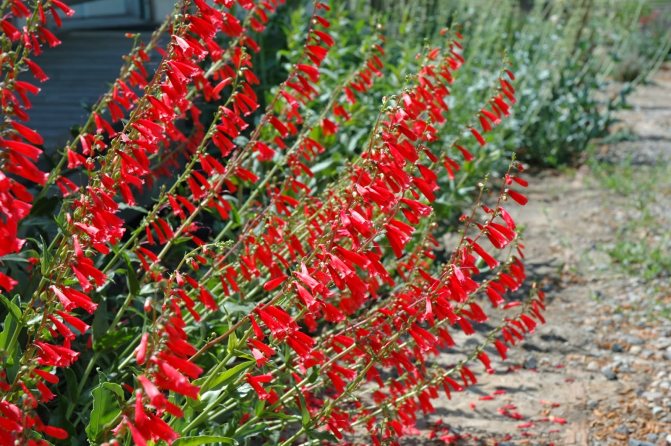

Sort the product, wash, cut into small pieces.- Pour half a glass of water into a saucepan (preferably enameled), add salt and citric acid. Bring the water to a boil.
- Place mushrooms in boiling water and cook for 30 minutes, adding water if necessary. Remove foam as foam forms on the surface.
- Drain the water (but do not pour it out), let the product drain. To do this, they must be placed in a colander.
- Pass the drained and cooled mushrooms through a meat grinder, and then put under a press.
- Mix the broth of mushrooms with the juice that appears after pressing. Filter the resulting liquid, pour into a saucepan and boil, stirring constantly, to half the original volume.
- Distribute the resulting syrupy liquid over the jars, filling them so that 1 cm remains to the neck of the jar. Cover with lids that have been boiled in advance.
- Place the jars in a pot of hot water. Sterilize the jars at low boil for half an hour.
- At the end of sterilization, close the jars and allow them to cool naturally.
Psilocybin Mushroom: How to Eat Different Types of Psilocybe
Features of woody mushrooms
Many species of woody mushrooms act as forest orderlies, as they grow on weakened trees and help the natural selection of quality species. Representatives of such "orderlies" known to us, for example, are honey mushrooms, beautifully growing on stumps in a large family and attracting mushroom hunters with a spicy aroma. In addition, they are delicious, crispy, especially marinated by gourmets.
But there are mushrooms that are completely different from traditional ones, they have neither a cap nor a leg. They are qualified and recognized by their shape and appearance, which reminds us of familiar things in everyday life. It never occurred to anyone to collect them and taste them, so the taste qualities of these eccentric specimens are not known for certain.
Such "xylotrophs can be distinguished by the description of their appearance:
- Pieces of meat (Ascocorine meat);
- Resin in the form of a drop (Exidia glandular);
- Bubble polyurethane foam (Dacrimyces disappearing);
- Corals, sponge (Kalocera).
Even among the fungi, there are parasites that eat their relatives. For example, sulfur-yellow hypocrea, which feeds on colonies of exsidia or tremors.
The northern climacodon, a representative of the Tinder subspecies, is a particularly dangerous parasite for the forest. Through cracks and cuts, it penetrates into the body of a healthy tree and completely destroys it in 4 years.
Gardeners and park workers should be wary of these parasites, as they can completely destroy the garden.
Differences
Sometimes poisoning occurs due to one piece of pale toadstool or red fly agaric, which fell on the table along with edible mushrooms. In order not to confuse edible and inedible mushrooms, it is necessary to understand exactly which specimens are common in the area, how they look. Only the well-known mushroom is placed in the basket.
Some varieties of edible and inedible crops are similar. Despite the similarities, they also have a number of differences.
- Appearance: the color of edible specimens is often dim, but there are exceptions. For example, a chicken mushroom has a bright yellow hat. Poison in inedible organisms repels insects. In edible specimens, however, there are most often a lot of worms and beetles. The edible varieties also have a skirt. Most poisonous ones do not have it.
- Change in color at a break (cut): edible and poisonous mushrooms are characterized by this feature. In edible specimens, it becomes beige or brown, while in poisonous specimens it acquires a brighter color (red, orange), or a dangerous mushroom turns blue.
- Smell: Often the edibility is determined by it. Almost all edible mushrooms have a pleasant aroma. Parasitic fungi and specimens not suitable for food have a chlorine or medicinal smell, but there are exceptions (fly agaric).
- Cap surface: Many inedible varieties have a sticky cap to the touch. It is worth avoiding those specimens that do not have a tubular layer under the cap.
- Base of the leg: in poisonous specimens, the base of the leg is almost always submerged (surrounded) by a special sac (volva) - the remainder of the common blanket. Edible mushrooms have no such formation. Also, in inedible and poisonous specimens, in addition to the volva, the base of the leg is expanded into a tuber-like, well-defined formation.
These are the main differences between edible and inedible mushrooms. Of the poisonous species on the territory of Russia, the most common are the pale grebe (green fly agaric), red fly agaric, slender pig and satanic mushroom. The pale toadstool is deadly.
Types of woody mushrooms
Mushroom hunters pay attention to outwardly unusual species found in the forest on the trunks of rotten or diseased trees, dead wood. In the middle of summer and autumn, you can find adults of the most interesting mushrooms, the description of which is presented below.
Ascocorine meat
It got its name because the fruit body resembles pieces of meat of pink-purple shades with plates no more than a centimeter, combined over one saucer. Most often found on birch stumps. It has no pronounced aroma. The unsightly view scares away mushroom gourmets, so its taste is unknown.
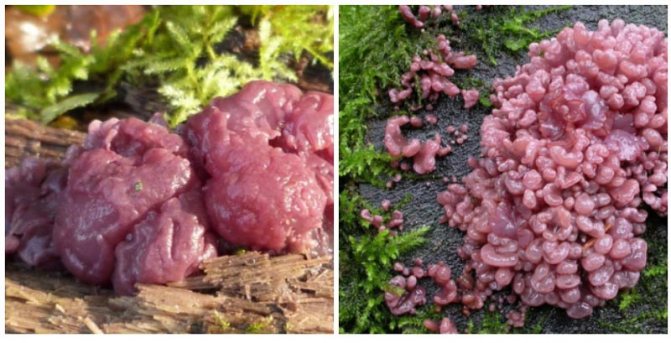

Bjorkander
Belongs to the tinder fungus family, it is distinguished by ribbon growth within one year. A mature mushroom of dark brown color resembles a braid of hats, no more than 3 cm in size.The pulp is fragile, gray in color, odorless. A thin, spore-bearing layer with a clear boundary separates the body of the fungus from the brown oily cap, which seems to be always wet and grayish at the ends.
It spreads on dead wood, fallen trees. It tastes like an ordinary tinder fungus.


Oyster mushroom
Oyster mushrooms quickly burst into our lives, making it much easier to prepare many dishes with rare species of woody mushrooms. Growing fast in an artificial environment, having a wonderful aroma and good taste, they have become the undoubted sales leaders. Specimens bred on mushroom farms are not comparable in taste to wild-growing varieties. They grow in large families on the trunks of living and dead deciduous fruit trees.
You need to look for them in the spring and autumn in the Crimea.
The fruiting body consists of a long elastic stem and a matte cap. Oyster mushrooms have a varied palette of colors - from pale gray to orange, and they are all edible and tasty.
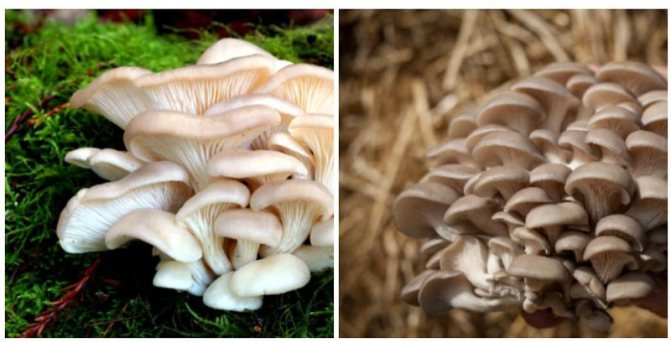

Hypocrea
Sulfur-yellow hypocrea is an inedible parasitic fungus that feeds on relatives of the Drozhalok family (most often, Exidia glandular). Accordingly, the seasons and places of growth of this species coincide with their "victims".
Appearing on the body of a trembling, hypocrea grows in several yellow spots, which then merge into one surface. It forms a large golden spot on the body of a tree fungus with black dots - spore-forming fruiting bodies. It looks like a dense, uneven sponge ranging in size from 1 to 15 cm.
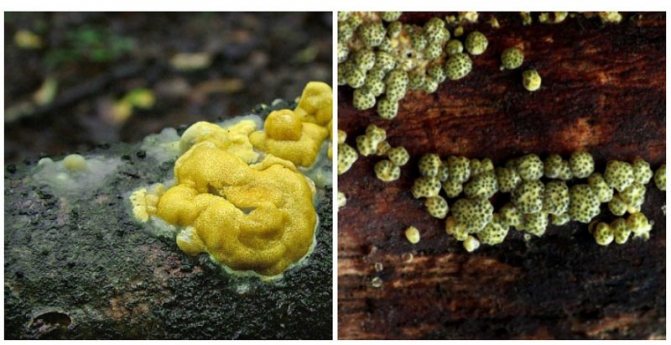

Mushroom ram
This fast growing fungus from the polypore family is also called Griffola curly. In our country, it is rare, only in deciduous forests on old logs and stumps. Such mushrooms weighing 9-10 kg have been found in nature.
Honey mushrooms
When mushroom pickers are asked what kind of mushrooms grow on stumps, they answer almost the same way. At least the first name is honey mushrooms, but then the list may differ. But honey mushroom is not a specific type of mushroom, but the name of a whole group in which representatives of various genera and families are gathered. In fact, the name "honey agaric" is considered popular and indicates the place where the fungus grows. The following types were attributed to mushrooms:
- The honey mushroom is real. Has a honey-yellow or rusty cap, but some families are greenish-yellow or brown. In young representatives, the cap is spherical, with sparse scales, in mature representatives it is flat with a small tubercle. Another name is autumn honey.
- Winter honey mushroom. Appears in October, may occur before early December. Warm winter does not disappear at all. Has a somewhat slimy cap, but this does not spoil the taste. The hat is light brown or yellow-orange. The edges may appear striped as the lower plates are visible through the thin flesh.
- Summer honey mushroom. Has a slightly corrugated cap, wavy towards the edge. The color of the cap is reddish or reddish brown. These stump mushrooms are edible and delicious. Appears in the forest at the end of May, occurs until the end of autumn. Mature mushrooms lose their globularity and become completely flat. There are no scales on the surface.
- Meadow honey fungus. This species grows in grass, and not on stumps like other mushrooms.
DETAILS: How to cook lard in onion skins according to the most delicious recipe
The benefits and harms of woody mushrooms
The benefits of edible woody mushrooms are scientifically based. There is absolutely no fat in them. Their main useful components are:
- vegetable protein;
- vitamins C, B, especially a lot of B3;
- Trace elements calcium, phosphorus, iron.
In such types of mushrooms as tinder fungus, shiitake, chaga, not culinary, but pharmaceutical properties prevail. Various substances and mixtures are prepared from them that can treat the symptoms of certain diseases:
- lack of iron in the blood;
- high blood pressure;
- high indicators of stomach acidity;
- reduced immunity.
Woody fungi can be considered harmful only because they spread widely and quickly on healthy trees in human-cultivated areas - gardens, parks, artificial forests. Getting on the bark of a damaged area of a healthy trunk, fungal spores multiply rapidly and destroy it in just a few years.
If wood damaged by animals or frostbitten is treated with garden pitch in time, this danger will disappear.
Potential harm
In some cases, woody mushrooms can harm the body and have a negative effect on humans:
- high chitin content can cause stomach upset, so do not overeat mushroom dishes;
- mushroom dishes should not be used for food for people prone to allergic reactions and with individual intolerance to mushrooms;
- the use of mushroom dishes for children of preschool and school age, as well as for pregnant and lactating women, even in a minimal amount, is undesirable;
- mushrooms should not be used for food to persons suffering from exacerbation of diseases of the gastrointestinal tract.
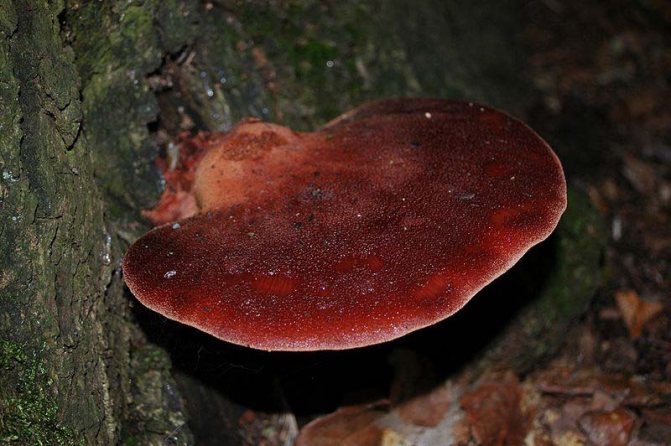

The mushroom season for the overwhelming majority of “quiet hunting” lovers lasts until the onset of severe autumn frosts, but some species of woody fungi grow even in the first winter month. It is best to collect it away from busy highways, large cities and industrial facilities, since fruit bodies very well absorb and retain all harmful substances and components contained in the soil, water or air. For the preparation of various dishes, it is advisable to use young specimens that have a richer mushroom aroma and delicate taste.
Mr. Dachnik recommends: wood mushrooms - useful properties, use in cooking
The Chaga birch tree mushroom has become famous for its medicinal properties - teas, decoctions from it have a powerful immunostimulating and tonic effect.
Farm mushroom planting has become a lucrative business and now we often see delicious and nutritious oyster mushrooms on sale, which are also woody. In nature, they are yellow, greenish and other shades and grow in a large family. Forest species are much more fragrant than their artificially bred relatives. A big plus is that they do not have poisonous counterparts.
Tree ears, as mushrooms are called due to their resemblance to the auricle, are very popular in oriental dishes. However, they are rarely prepared as an independent dish, since they do not have a special aroma and pronounced taste. Mushrooms are good as a side dish paired with meat, giving it a subtle haze flavor. The crispy and dense texture is delicious and nutritious, especially well seasoned.
Undoubtedly, woody mushrooms have taken a worthy place in human nutrition: it is not for nothing that we have begun to meet them more and more often on supermarket shelves, thereby enriching the diet with healthy and nutritious protein products.
>
Cooking julienne
Julienne is a very famous hot appetizer that came to us from France, and it won't take long to prepare it. Julienne is a dish of mushrooms baked in cream or sour cream under a cheese crust.
Usually julienne is cooked and served in a special cocotte mold, but you can cook the dish, for example, in clay pots. Ingredients (per serving):
- Boiled chicken breast - 200-300 g.
- Fried mushrooms - 200-300 g.
- Sauteed onions in butter - 1 pc.
- Hard cheese - 150-200 g.
- Sour cream - 200-250 g.
- Salt, pepper, flour.
- Butter - 50 g (for onions and sauce).
Mother-in-law mushroom language: description, useful properties, recipes
Any kind of mushroom can be used for the recipe. Step by step cooking method:
- Boil the mushrooms and fry in vegetable oil. Cut the boiled chicken fillet into cubes. Saute the onion in butter.
- Grease the cocotte with butter. Then put the chicken fillet, mushrooms and onions there.
- Pour the julienne into a cocotte with ready-made sour cream sauce.
Preparation of sour cream sauce: sauté 1-2 minutes 1 tbsp in a hot dry frying pan. a spoonful of flour, then add sour cream (if the sour cream is very thick, then you can dilute it a little with water). Boil sour cream for a few minutes, season with salt and pepper to taste. Add some butter. When the butter has melted well, turn off the heat. If there are lumps in the sauce, rub the sauce through a strainer. Instead of sour cream sauce, you can simply add sour cream, lightly salt and pepper to taste.
Sprinkle julienne on top with hard cheese and place in the oven for 7-10 minutes. Serve the ready-made julienne to the table, decorating with herbs.
Answers to common questions
Mushrooms are quite complex organisms, and often hazardous to health, so a lot of questions arise about their collection and use.
Are all fungi that grow on trees a parasite?
No, there are varieties that have settled on an already sick dying plant. They did not become the reason for his death, and, on the contrary, in nature they play the role of orderlies, clearing the forest from debris, turning trunks and stumps into humus.
How to remove a mushroom from a tree?
To use the mushroom itself, it is simply cut close to the bark, without damaging the attachment point. If we are talking about how to remove the parasite from the trunk, then in most cases this process is useless, since the fungus consists of a mushroom body and mycelium, that is, the roots that are in the trunk and it is impossible to remove them from there. Cutting off the fruiting body, unfortunately, will not cure the tree, it may just prolong its life a little.
Mushrooms from which trees are the most dangerous in our area?
There is no especially dangerous, deadly poisonous tree fungi in our latitudes and there is no relationship between the “toxicity” of the fungus and the species of wood. But this does not mean that all of them can be eaten. Many of them can cause health problems, especially if you consume too much of them.
Like all common edible mushrooms, woody mushrooms are also healthy and even tasty in many ways. The main thing is to study them so as not to make mistakes when collecting, as well as their preparation and processing features.

